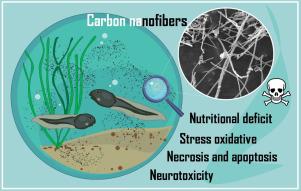Aquatic Toxicology ( IF 4.5 ) Pub Date : 2021-02-27 , DOI: 10.1016/j.aquatox.2021.105795 Abraão Tiago Batista Guimarães , Fernanda Neves Estrela , Aline Sueli de Lima Rodrigues , Rafael Henrique Nóbrega , Ives Charlie-Silva , Guilherme Malafaia

|
Although carbon nanotubes’ (CNTs) toxicity in different experimental systems (in vivo and in vitro) is known, little is known about the toxic effects of carbon nanofibers (CNFs) on aquatic vertebrates. We herein investigated the potential impact of CNFs (1 and 10 mg/L) by using Physalaemus cuvieri tadpoles as experimental model. CNFs were able to induce nutritional deficit in animals after 48-h exposure to them, and this finding was inferred by reductions observed in body concentrations of total soluble carbohydrates, total proteins, and triglycerides. The increased production of hydrogen peroxide, reactive oxygen species and thiobarbituric acid reactive substances in tadpoles exposed to CNFs has suggested REDOX homeostasis change into oxidative stress. This process was correlated to the largest number of apoptotic and necrotic cells in the blood of these animals. On the other hand, the increased superoxide dismutase and catalase activity has suggested that the antioxidant system of animals exposed to CNFs was not enough to maintain REDOX balance. In addition, CNFs induced increase in acetylcholinesterase and butyrylcholinesterase activity, as well as changes in the number of neuromasts evaluated on body surface (which is indicative of the neurotoxic effect of nanomaterials on the assessed model system). To the best of our knowledge, this is the first report on the impact of CNFs on amphibians; therefore, it broadened our understanding about ecotoxicological risks associated with their dispersion in freshwater ecosystems and possible contribution to the decline in the populations of anurofauna species.
中文翻译:

碳纳米粉会影响无瓣金枪鱼吗?涉及中性Phys虫的研究(菲岑格,1826年)
尽管在不同的实验系统(体内和体外)中碳纳米管(CNTs)的毒性是已知的,但对于碳纳米纤维(CNFs)对水生脊椎动物的毒性作用知之甚少。我们在这里研究了使用藜(Physalaemus cuvieri)的CNF(1和10 mg / L)的潜在影响as作为实验模型。CNFs暴露于动物48小时后能够诱导动物营养缺乏,而这一发现是由于体内总可溶性碳水化合物,总蛋白质和甘油三酸酯浓度降低而推断出来的。暴露于CNF的t中过氧化氢,活性氧物质和硫代巴比妥酸反应性物质产量的增加表明REDOX体内稳态转变为氧化应激。该过程与这些动物血液中凋亡和坏死细胞的数量最多有关。另一方面,增加的超氧化物歧化酶和过氧化氢酶活性表明,暴露于CNF的动物的抗氧化系统不足以维持REDOX平衡。此外,CNF诱导了乙酰胆碱酯酶和丁酰胆碱酯酶活性的增加,以及在体表上评估的神经质数量的变化(这表明纳米材料对评估的模型系统具有神经毒性作用)。据我们所知,这是关于CNF对两栖动物影响的第一份报告。因此,它拓宽了我们对与其在淡水生态系统中扩散有关的生态毒理学风险的理解,并可能有助于对动物种类的减少做出贡献。



























 京公网安备 11010802027423号
京公网安备 11010802027423号